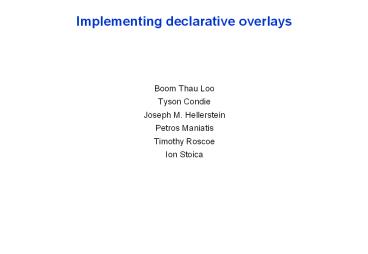Implementing declarative overlays - PowerPoint PPT Presentation
Title: Implementing declarative overlays
1
Implementing declarative overlays
- Boom Thau Loo
- Tyson Condie
- Joseph M. Hellerstein
- Petros Maniatis
- Timothy Roscoe
- Ion Stoica
2
Presentation
- Introduction
- P2 approach
- Overlog examples (NARADA mesh)
- Implementation
- Performance
- Conclusions
3
INTRODUCTION
- Overlay networks are used in variety of
distributed systems. - P2 a facility, deployable as a service or
library, for the declarative construction,
maintenance, and sharing of an overlay network - Applications concise a logical description of an
overlay network, and P2 executes this to maintain
routing data structures, perform resource
discovery and forwarding functionality. - Goal simplify the process of selecting,
implementing, deploying and evolving an overlay
network design.
4
INTRODUCTION
- P2 does not aim as optimized performance as e.g.
C, C or Java implementations. - CHORD 47 logical rules (full Overlog
specification), MACEDON 320 statements. - P2 Simplified approach (16 rules, NARADA)
- Target is to demonstrate that declarative overlay
descriptions can be implemented by P2 with
acceptable performance.
5
P2 approach
- A combination of protocol- and structure centric
approach that would be most attractive for
overlay specification and runtime. - P2 employs 2 types on relations
- Soft-state tables (network state)
- Streams of transient tuples (stream query
engines)
6
Overlog
- P2 specification language for overlays.
- Overlog designed for distribution of context data
and messages. - Overlog P2 adds constructs to specify physical
distribution properties. - Tuples are physically generated, stored and sent
- Queries over streams
- Deletion of tuples
7
NARADA
- Summary of functionality (16 rules)
- Each node maintains a set of neighbors, and a set
of members in the group. - Each member epidemically propagates keep-alive
messages for itself - (Associated to monotonically increased
sequence number) - Neighbors exchange information about membership
liveness and sequence numbers. - (members learn the liveness of each member)
- If member fails to hear direct neighbor for a
period, it declares neighbor dead. - (updates its own membership state and
propagates the rest population) - Periodical updates to measure roundtrip latency.
- If latency time improves -gt node A adds node B to
its neighbor set - If latency time exceeds -gt node A removes node B
from its neighbor set
8
Example of NARADA based Overlog declarations
- Overlog syntacts ltruleIDgtltheadgt - ltbodygt
- Neighbor and member are tables whose tuples are
retained for 120 seconds - materialize(neighbor, 120, infinity, keys(2)).
- materialize(member, 120, infinity, keys(2)).
- materialize(sequence, infinity, 1, keys(2)).
- Rule (R1)
- R1 refreshEvent(X) - periodic(X, E, 3).
- Table refreshEvent has a row with value (X),
for any X, if table periodic has a row with value
(X, E, 3), for some E.
9
P2 Implementation
- Platform Linux
- Code C
- Codelines 20k ( 3rd party support)
10
Block diagram of a P2 node
11
Performance (FIG. 3)
12
Performance (FIG. 4)
13
Conclusion
- The P2 approach looks promising
- Overlays can be specified concisely
- Performance is acceptable
- Overlog allows easy modification
14
Thank You!

